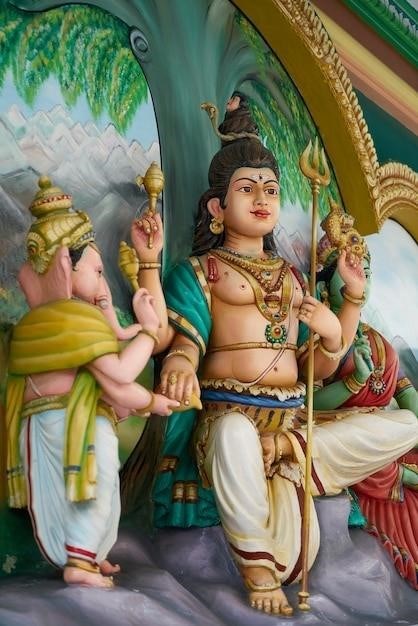Srimad Valmiki Ramayana⁚ A Timeless Epic
The Srimad Valmiki Ramayana, a Sanskrit epic poem, narrates the journey of virtue to annihilate vice. This epic poem is a smriti, which translates to “from memory,” and its story has profoundly affected South and Southeast Asian literature, art, religions, and cultures. The Ramayana is available in English translation and in PDF format, allowing readers to explore this timeless epic.
The Story of Rama
The Srimad Valmiki Ramayana tells the story of Rama, an incarnation of the god Vishnu, and his journey to restore dharma (righteousness) and vanquish evil. The epic begins with Rama, the prince of Ayodhya, being exiled by his stepmother, Kaikeyi, who desires her own son, Bharata, to inherit the throne. Rama, along with his wife Sita and brother Lakshmana, leaves Ayodhya and resides in the forest.
During their exile, Rama and Sita are abducted by Ravana, the demon king of Lanka. Rama, with the help of his loyal monkey-army led by Hanuman, sets out to rescue Sita. A fierce battle ensues between Rama and Ravana, culminating in Rama’s victory and the restoration of Sita. Rama returns to Ayodhya as king, where he is welcomed with great joy by his subjects.
The Ramayana is not just a story of adventure and heroism, but also a profound exploration of love, loyalty, duty, and the struggle between good and evil. Rama embodies the ideal of a righteous king, while Sita represents the epitome of virtue and devotion. The epic also features a diverse cast of characters, including the wise sage Valmiki, the cunning demon king Ravana, and the loyal Hanuman.
The Significance of the Ramayana
The Ramayana is not merely a tale of adventure and romance; it carries profound significance in Hindu culture and beyond. It serves as a moral compass, illuminating the path of righteousness and virtue. The epic’s central message revolves around the triumph of good over evil, emphasizing the importance of dharma (righteousness) and the consequences of adharma (unrighteousness).
Rama, the protagonist, embodies the ideal of a righteous king and serves as a model for moral conduct, selflessness, and dedication to duty. Sita, his wife, represents the epitome of virtue, loyalty, and resilience. The epic’s themes resonate across diverse cultures, making it a timeless story that continues to inspire and guide generations.
The Ramayana’s influence extends beyond India, impacting literature, art, and culture in Southeast Asia, where it has been adapted and reinterpreted in various forms. The epic’s enduring relevance lies in its universal appeal, its exploration of human emotions and values, and its timeless message of hope and redemption.
The Sanskrit Text
The Srimad Valmiki Ramayana, originally composed in Sanskrit, is a treasure trove of ancient Indian knowledge and wisdom. The Sanskrit text, written in the elegant and expressive Devanagari script, is a testament to the richness of the language and the profound literary skills of Valmiki, the epic’s author. The Sanskrit verses are renowned for their poetic beauty, intricate metaphors, and philosophical depth, capturing the essence of the story and its profound themes.
The original Sanskrit text of the Ramayana has been preserved and studied by scholars for centuries, serving as a source of inspiration and a guide for understanding the epic’s nuances. The text has been meticulously edited and published in various editions, including the critically acclaimed Baroda Critical Edition, which is considered a definitive version.
Access to the original Sanskrit text is crucial for a deeper understanding of the Ramayana, allowing readers to appreciate its literary brilliance and delve into the intricacies of its language and symbolism. The availability of the Sanskrit text, along with English translations, enables readers to explore the epic’s layers and appreciate its enduring value.
English Translations
The Srimad Valmiki Ramayana has been translated into English by numerous scholars and poets, making this timeless epic accessible to a global audience. These translations have played a vital role in disseminating the story and its profound messages beyond India’s borders, introducing generations of readers to the epic’s rich narrative, diverse characters, and philosophical themes.
English translations of the Ramayana vary in style and approach, reflecting the translators’ individual perspectives and interpretations. Some translations are more literal, aiming to stay close to the original Sanskrit text, while others are more creative and interpretive, offering a more accessible and engaging reading experience.
Notable English translations of the Ramayana include those by Ralph T.H. Griffith, Hari Prasad Shastri, and Robert P. Goldman, each offering unique insights and perspectives. The availability of these translations, both in print and digital formats, provides readers with a wide range of options to choose from, enabling them to explore the epic’s depths and discover its timeless wisdom.
The Ramayana in PDF Format
The accessibility of the Srimad Valmiki Ramayana has been significantly enhanced by the availability of PDF versions, allowing readers to easily access and engage with the epic on various devices. These digital formats offer a convenient and readily available resource for scholars, students, and general readers interested in exploring the Ramayana’s vast narrative and its enduring messages.
PDF versions of the Ramayana are available in various formats, including complete translations, individual cantos, and even Sanskrit texts with English translations. Some PDFs include detailed annotations and commentaries, enriching the reading experience and offering deeper insights into the epic’s complex themes and intricate symbolism.
The availability of these PDF versions has democratized access to the Ramayana, making it readily available to a broader audience. Readers can now delve into this epic tale at their convenience, exploring its profound themes of dharma, love, loyalty, and the triumph of good over evil, regardless of location or time constraints.
Valmiki’s Role in the Ramayana
Valmiki, revered as the Adi Kavi (the first poet) in Sanskrit literature, is credited with authoring the Srimad Valmiki Ramayana. His role in the epic is multifaceted, encompassing not just authorship but also the embodiment of spiritual transformation and the embodiment of poetic inspiration.
According to tradition, Valmiki was initially a bandit named Ratnakar, known for his cruelty and violence. However, a profound encounter with the sage Narada led to a transformative experience, leading him to renounce his past and embark on a path of spiritual seeking. It was during this period of deep meditation that he received the name Valmiki, meaning “one born of ant-hills,” symbolizing his emergence from a state of ignorance to enlightenment.
As Valmiki delved deeper into his spiritual journey, he was inspired to narrate the epic tale of Rama, Sita, and Lakshmana. The Ramayana, attributed to him, became a seminal work in Sanskrit literature, shaping not only the literary landscape but also the cultural and spiritual landscape of India and beyond.
The Ramayana’s Influence

The Srimad Valmiki Ramayana’s influence extends far beyond the realm of literature, permeating the fabric of Indian culture and beyond. Its impact can be seen in various aspects of life, from art and architecture to religious practices and societal values.
The Ramayana’s narrative has inspired countless works of art, including paintings, sculptures, and theatrical performances. The iconic characters of Rama, Sita, Hanuman, and Ravana have become enduring symbols in Indian art, representing virtues like righteousness, devotion, courage, and the struggle against evil.
The epic’s themes of dharma (righteousness), karma (action and consequence), and bhakti (devotion) have deeply influenced Hindu philosophy and religious practices. The Ramayana’s depiction of Rama as an ideal king and embodiment of dharma has served as a guiding principle for rulers and individuals alike. Its portrayal of the divine in human form, through Rama’s avatarhood, reinforces the concept of God’s presence in the world.
Furthermore, the Ramayana’s influence extends to South and Southeast Asia, where it has been adapted and reinterpreted in various languages and cultures. The epic’s universal themes of love, duty, and the triumph of good over evil have resonated with people across different backgrounds, solidifying its position as a timeless tale of human experience.
The Ramayana’s Relevance Today
Despite being composed centuries ago, the Srimad Valmiki Ramayana remains remarkably relevant in today’s world. Its timeless themes and enduring characters continue to resonate with modern audiences, offering valuable insights into human nature and the complexities of life.
The Ramayana’s emphasis on dharma, righteousness, and ethical conduct holds significant relevance in a world grappling with moral dilemmas and societal challenges. The epic’s portrayal of Rama’s unwavering commitment to truth and justice serves as a powerful reminder of the importance of ethical leadership and personal integrity.
Moreover, the Ramayana’s exploration of themes like love, sacrifice, and the struggle against adversity continues to inspire and resonate with individuals facing personal challenges. The epic’s depiction of Sita’s unwavering loyalty and Hanuman’s unwavering devotion offer timeless lessons in love, perseverance, and the power of faith.
In a world increasingly defined by globalization and cultural exchange, the Ramayana’s universal themes of human experience and the search for meaning transcend cultural boundaries. Its timeless story continues to inspire and inform generations, reminding us of the enduring values that bind us together as human beings.
The Ramayana in Different Languages

The Srimad Valmiki Ramayana, originally composed in Sanskrit, has transcended linguistic boundaries, finding expression in a multitude of languages across the globe. This testament to the epic’s enduring appeal speaks volumes about its universal themes and relatable characters.
Beyond its Sanskrit origins, the Ramayana has been translated into numerous Indian languages, including Hindi, Tamil, Telugu, Marathi, and Bengali. These translations have ensured the epic’s accessibility to a wider audience, allowing generations of Indians to connect with its timeless story and values.
The Ramayana’s influence extends beyond India, reaching Southeast Asian countries like Indonesia, Thailand, Malaysia, and Cambodia. These regions have adopted the epic’s narrative, incorporating it into their own cultural traditions and literary works. The Ramayana’s journey across languages reflects its enduring power to inspire and captivate audiences across cultures and geographical boundaries.
Furthermore, the Ramayana has been translated into English, making it accessible to a global readership. These English translations, along with the availability of PDF versions, allow readers worldwide to engage with the epic’s profound themes and explore its rich literary and cultural heritage.
Exploring the Ramayana
For those eager to delve into the world of the Srimad Valmiki Ramayana, several avenues present themselves. One avenue is the exploration of the original Sanskrit text, often accompanied by English translations. This allows readers to experience the beauty of the language and gain a deeper understanding of the nuances of the narrative.
Another avenue is the exploration of various English translations of the Ramayana. These translations offer diverse interpretations and styles, enriching the reader’s understanding of the epic’s themes and characters. Some translations emphasize the epic’s literary qualities, while others focus on its philosophical and religious aspects.
For a convenient and accessible approach, exploring the Ramayana in PDF format provides a readily available resource. These PDFs often include the Sanskrit text alongside English translations, enhancing the reading experience. They can also be easily downloaded and shared, promoting wider access to this timeless epic.
Beyond textual exploration, the Ramayana can be experienced through its various adaptations. From theatrical productions to cinematic interpretations, these adaptations offer unique perspectives on the epic’s story and characters, enhancing its appeal to a wider audience.
